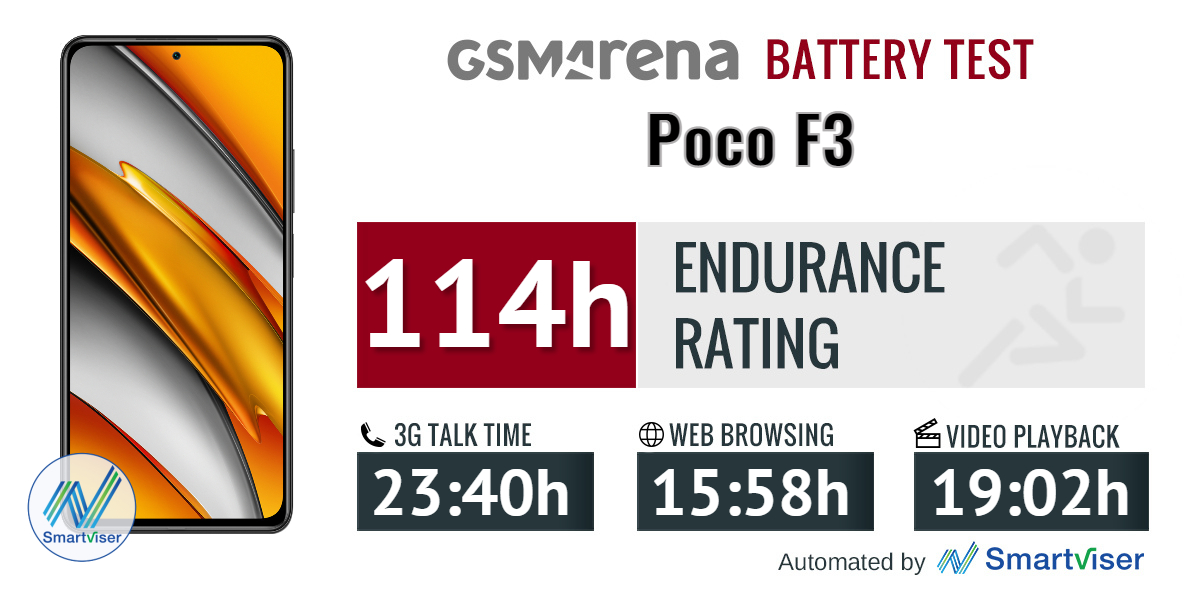GSMArena Team, 02 April 2021oco F
Poco F3 review
3 review
Poco F3 review
| 128GB 6GB RAM | $ 409.80 | |
| 256GB 8GB RAM | $ 519.80 | |
| SHOW ALL PRICES | ||
Introduction
The Pocophone brand is often associated with performance on the cheap, and that's probably the apt description for the latest phone we have for review - the Poco F3. It's more than that, though - it's like a flagship on the cheap, or as this other company would have called it - a flagship killer.
The Poco F3 is jam-packed with top-notch features starting with its beautiful glass body with a metal frame. The F3 has a 6.67" AMOLED screen with 120Hz refresh, one of the fastest platforms available today - the Snapdragon 870 5G chip, loud stereo speakers with Dolby Atmos, a versatile triple-camera setup, and a large battery with fast charging.

The rear camera is your typical budget arrangement, and that's probably the biggest cost-cutting decision to happen on the F3. There is a 48MP primary, an 8MP ultrawide shooter, and a 5MP macro enhanced with autofocus. The punch-hole at the front contains a 20MP selfie shooter. Sure, it's no real flagship, but hey, it's not too shabby either.
The Poco F3 is among the first phones to employ the enhanced version of last year's Snapdragon 865. That's the new Snapdragon 870, which should be about 10% faster. Paired with that 1080p screen, the hardware should also be doing a fabulous job in graphics-intensive tasks, too.

The Poco F3 isn't a massive upgrade over the F2 Pro, though. It sure packs a better 120Hz AMOLED and stereo speakers than its predecessor, but we expect the processing performance to be similar. The F2 Pro even had higher-resolution main and ultra-wide cameras. But there is a big case to be made here - the Poco F3 price at launch is almost half the Poco F2's, and that's a big deal.
Indeed, the Poco F3 seems to be packing a lot of unexpectedly good specs. Let's scroll through those now.
Xiaomi Poco F3 specs at a glance:
- Body: 163.7x76.4x7.8mm, 196g; Glass front (Gorilla Glass 5), glass back (Gorilla Glass 5), aluminum frame.
- Display: 6.67" AMOLED, 120Hz refresh, 360Hz touch sampling, HDR10+, 1300 nits (peak), 1080x2400px resolution, 20:9 aspect ratio, 395ppi.
- Chipset: Qualcomm SM8250-AC Snapdragon 870 5G (7 nm): Octa-core (1x3.2 GHz Kryo 585 & 3x2.42 GHz Kryo 585 & 4x1.80 GHz Kryo 585); Adreno 650.
- Memory: 128GB 6GB RAM, 256GB 8GB RAM; UFS 3.1.
- OS/Software: Android 11, MIUI 12 for POCO.
- Rear camera: Wide (main): 48 MP, f/1.8, 25mm, 1/2", 0.8µm, PDAF; Ultra wide angle: 8 MP, f/2.2, 15mm, 119˚; Macro: 5 MP, f/2.4, 49mm, 1/5.0", 1.12µm, AF.
- Front camera: 20 MP, f/2.5, (wide), 1/3.4", 0.8µm.
- Video capture: Rear camera: 4K@30fps, 1080p@30/60/120/240/960fps, gyro-EIS; Front camera: 1080p@30fps, 720p@120fps.
- Battery: 4520mAh; Fast charging 33W, 100% in 52 min (advertised), Power Delivery 3.0, Quick Charge 3+.
- Misc: Fingerprint reader (side-mounted); Stereo speakers; NFC; Infrared port.
We appreciate the stereo speakers and the fast charging, but we can't but miss the microSD slot and the 3.5mm jack. The writing has been on the wall for a couple of years now, sure, but still. Poco users usually expect these features to be present, and they are not on the F3. There is no FM radio on the Poco F3, if you were wondering.
Enough with the introductions, it's time we unbox it.
Unboxing the Poco F3
The Poco F3 ships within a big black box with the usual yellow Poco insignia. The retail bundle is your typical Xiaomi treatment - there is a fast 33W power adapter, a 3A-rated USB-A-to-C cable, and a transparent silicone case. That case has a small protective cover for the USB port, which boosts the ingress protection, but gets annoying fast when you need to charge the phone or plug a wired headset.
And speaking about headsets, the Poco F3 doesn't offer a 3.5mm jack, and that's why the maker is also offering a 3.5mm-to-USB-C adapter as part of the bundle. Nice!

Finally, if you are an avid Poco phone, you'll also be happy to find a bunch of Poco stickers, which you can put on your favorite gadgets, PCs, or maybe your car bumper?
The Poco F3 comes with this very thin screen protector that was applied in the factory, but it's was so cheap and hard to keep to clean from smudges that we got rid of it quickly.
Design, build quality, handling
The Poco F3 looks a lot like the Mi 11 - Xiaomi's current flagship - and that's great. The new F3 has two Gorilla Glass 5 panels on both sides, while the aluminum frame, curved and glossy, is shaped after the one on the Mi 11.

The camera setup on the back also takes after the Mi 11's, and that's good - the design is somewhat different from what we've used to see lately, and it allows all recent Xiaomi phones to stand out.
There is no mention of IP53 rating or water-repellent coating with the F3 - like it was the case with the Poco X3 and X3 Pro. Maybe the F3 omits one, maybe Xiaomi needs more time to confirm it. We can say two things for sure - the Poco F3 has fewer ports than the X3 Pro - hence fewer potential water entries - and it seems the F3 has similar SIM and USB port insulations as the ones on the Poco X3 Pro. Long story short - we do believe the F3 is protected against splashes, but for some reason, the maker isn't advertising it as such.

Anyway, we don't really expect a €300 or so phone to be water-resistant, but since many of its Xiaomi-made peers are IP53-rated, we decided to dig a little bit into the subject.
The Poco F3 is available in three different colors - Arctic White, Night Black (ours), and Deep Ocean Blue. The black and white hues are all-glossy and mirror-like, but there are no gradients or weird reflections. This super glossiness eventually turns into a smudge fest and if that's not your cup of tea, maybe you should consider the blue version - it divides the back into three different zones, each with its own finish.
We like our black version; it somehow reminds us of ceramic, but as we said - it gets smudged up in mere minutes, and the occasional wiping is a must.
Let's take a step back from the design and look at the front. Most of it is taken by the 6.67-inch AMOLED screen of 1080p resolution and 120Hz refresh rate. It's a nice upgrade over the Poco F2 and probably a similar panel to what we saw on the Redmi Note 10 Pro.
The screen bezels seem reasonably thin, as is the punch-hole - one of the tiniest we've seen. The selfie camera is properly centered inside the cutout, something that was an issue on the Redmi Note 10 Pro.

There is no under-screen fingerprint - it's placed on the frame instead. But under the thin grille above the screen is one of the stereo speakers, and it's nicely loud and clean. It also doubles as an earpiece, of course.

There is no notification LED on the Poco F3, but you can opt for screen breathing lights even if you've disabled Always-on screen, which is a good enough alternative.
The glossy back of the Poco F3 looks magnificent when it's clean. It contains the two-step camera setup - the first floor contains the LED flash and the 360-degree ambient light sensor. The second glass is jutting out of the first and has the three snappers - 48MP main + 8MP wide + 5MP macro - and a microphone. Both glass pieces seem to be surrounded by thin metal bands.

Now, let's take a close look at the sides of the Poco F3. The left side is bare, while on the right-hand side you can find as the volume rocker and the power/lock key as usual.

The power key's surface also doubles as an always-on and speedy fingerprint reader. It never failed us, and the speed and accuracy are just phenomenal.
The top of the Poco F3 houses two grilles - the first one is for the top speaker, while the second one hides another microphone and the IR blaster.

The other stereo speaker, the USB-C port, the dual-SIM tray, and the primary microphone (the mouthpiece) are all at the bottom.
The Poco F3 measures 163.7 x 76.4 x 7.8 mm, which is about the same as the Redmi Note 10 Pro, but 1-2mm thinner than the Poco F2 and Poco X3 Pro. Same goes with the weight - the F3 is about 196 grams, about 20g lighter than the F2 Pro and X3 Pro.
The Poco F3 may have a glossy and curved back, as well as a curved frame, but it somehow ended up with a shape that provides an acceptable grip. The phone has a metal frame, but you can't see antenna strips because the whole thing was sprayed with some grippy paint. And it turns out that's enough for an overall pleasurable and safe handling experience.

The Poco F3 is a good-looking phone with a premium build for this mid-range class, and we like how the phone has turned out. We would have loved it even better with an official IP53 raging, but if it meant a higher price, then maybe it was the right decision to skip it. After all, unlike Realme 8 Pro, Poco has put rubber gaskets everywhere it matters.
Superb 6.67" AMOLED with 120Hz refresh rate
The Poco F3's display is probably the biggest upgrade since the F2 Pro and the most noticeable one. It is still a 6.67" AMOLED of extended 1080p resolution, but now it supports 120Hz refresh rate and 360Hz touch sampling.
The screen resolution is the typical 1,080 x 2,400 pixels or 395ppi. There is a tiny punch-hole cutout for the selfie camera, but unlike on the Redmi Note 10 Pro, here the camera has been positioned much better inside.

So, the display features Gorilla Glass 5 protection. Like other Xiaomi phones, this one also comes with a thin protective film already applied on the screen, but it's quite cheap and a massive fingerprint magnet, so we peeled it off in the first hour. If you really need a screen protector over, you'd be better off buying a better quality aftermarket one.
The Poco F3 screen supports 60Hz (static) and 120Hz (adaptive) refresh rate.
There is also HDR10+ certification and combined with the Widevine L1 DRM support, you can squeeze the maximum quality of any video streaming service. We tried various HDR-capable streaming services like Netflix, Prime, YouTube - and they all offered us Full HD HDR quality.
Just like on the Redmi Note 10 Pro and the Poco X3 Pro you can choose between 60Hz and 120Hz screen refresh rates called Standard and Medium. The (medium) 120Hz option works dynamically - it can switch automatically between 30Hz, 60Hz, 90Hz and 120Hz depending on the content you are currently displaying. The Poco F3 screen is always showing 120fps throughout the UI and all system apps, but it reverts to 60Hz when the picture is static for battery-saving reasons - that's a typical behavior across most of the HRR phones out there.

Other than that - the screen is working in 120Hz for supported apps and games (like Dead Trigger 2), and 60Hz in Netflix, YouTube, Prime Video, the default Mi Video player, and some games. We saw 90Hz when using Picture in Picture and when fast switching between apps. We couldn't make the screen drop the refresh rate down to 30Hz though.
Poco is promising the F3 screen can achieve a maximum auto-brightness of 900 nits (typical) and 1300nits (peak/local) when watching HDR content.
And we can confirm the 700nits auto brightness - 711 nits to be specific. It is achievable when the screen is set to Auto-Brightness or when you turn the Sunlight Boost in Manual Brightness Mode. Otherwise, the maximum brightness at the end of the brightness slider is 511 nits - which, admittedly, is still plenty enough.
One thing we didn't like is the brightness scrubber levels - for example, 200 nits are achieved at about 85% of the slider, and the other 300+ nits are represented by the last 15% of the slider movement. That's some poor control design, and it annoyed us a lot, especially when we wanted to get a brighter but NOT THAT bright screen.
We measured the minimum brightness at point white, and it is just 2.1 nits, which is commendable.
| Display test | 100% brightness | ||
| Black, | White, | ||
| 0 | 511 | ∞ | |
| 0 | 716 | ∞ | |
| 0 | 516 | ∞ | |
| 0 | 854 | ∞ | |
| 0.314 | 461 | 1468:1 | |
| 0.332 | 437 | 1316:1 | |
| 0.354 | 460 | 1299:1 | |
| 0.515 | 631 | 1225:1 | |
| 0.327 | 458 | 1401:1 | |
| 0.4 | 534 | 1335:1 | |
| 0 | 457 | ∞ | |
| 0 | 725 | ∞ | |
| 0 | 475 | ∞ | |
| 0 | 682 | ∞ | |
| 0 | 454 | ∞ | |
| 0 | 627 | ∞ | |
| 0 | 459 | ∞ | |
| 0 | 585 | ∞ | |
| 0.376 | 484 | 1287:1 | |
| 0.667 | 571 | 856:1 | |
| 0.349 | 498 | 1427:1 | |
| 0.434 | 613 | 1412:1 | |
| 0.355 | 456 | 1285:1 | |
| 0.487 | 616 | 1265:1 | |
| 0 | 386 | ∞ | |
| 0 | 794 | ∞ | |
There are three predefined Color presets - Auto, Saturated, Standard - each representing a specific color space.
The Auto option is tuned to reproduce Wide Color Gamut content faithfully, but it also adjusts the colors to correspond to your current lighting (like Apple's True Tone). We saw some very good calibration in our office's normal daylight conditions, even if with some bluish tinge of the white and gray hues.
The Standard setting corresponds to sRGB, and the screen shows an excellent calibration.
Finally, the Saturated mode makes the colors pop, and they are no longer as accurate to DCI-P3.
Battery life
The Poco F3 is powered by a rather large 4,520mAh battery - nearly 200mAh smaller than the F2's and 500mAh less than the Redmi Note 10 Pro and Poco X3 Pro. It still seems enough for such a smartphone, so we expect some good numbers on our battery life test.
And indeed, the Poco F3 scored some impressive times! The phone posted an outstanding battery endurance rating of 114 hours! It did lovely on the screen-on tests, and you can do calls for a full day.
The phone always shows videos at 60Hz, and it drops the refresh when reading websites to 60Hz, too, with the exceptions being when you touch the screen. Meaning these times are also representative of when the display is set to a static 60Hz refresh rate.
Our battery tests were automated thanks to SmartViser, using its viSerDevice app. The endurance rating above denotes how long a single battery charge will last you if you use the Poco F3 for an hour each of telephony, web browsing, and video playback daily. We've established this usage pattern so that our battery results are comparable across devices in the most common day-to-day tasks. The battery testing procedure is described in detail in case you're interested in the nitty-gritty. You can check out our complete battery test table, where you can see how all of the smartphones we've tested will compare under your own typical use.
Charging speed
Just like the Redmi Note 10 Pro and Poco X3 Pro, among other Xiaomi phones, the Poco F3 battery supports 33W Mi Fast charging and the phone ships with a 33W adapter and a 3A-rated cable.

The bundled charger refills 67% of the F3's dead batter in 30 minutes.
30min charging test (from 0%)
A full charge requires 56 minutes - a truly impressive time for this class!
Time to full charge (from 0%)
Speakers
The Poco F3 features a hybrid stereo speaker setup, where the earpiece also doubles as a speaker. While the configurations we've experienced on the Redmi Note 10 Pro and the X3 Pro seemed to have equally loud and powerful speakers, that is not the case on the Poco F3.
The top speaker has two grilles - one front-facing and another one at the top of the phone, on the frame. The front hole is letting high notes through, while the top grille provides for some bass. This speaker seems to be a bit quieter than the bottom-firing one and suited for mostly high frequencies.
Then there is the bottom speaker, which is louder and provides good bass and excellent mid-tones. And you've probably guessed that right - the high tones aren't its strong suit.
And it's good news from here. The F3 setup scored a Very Good overall loudness on our test and showed us good balance when neither speaker is muffled. We liked the sound quality too; there is some good representation across bass, mid and high tones.
Use the Playback controls to listen to the phone sample recordings (best use headphones). We measure the average loudness of the speakers in LUFS. A lower absolute value means a louder sound. A look at the frequency response chart will tell you how far off the ideal "0db" flat line is the reproduction of the bass, treble, and mid frequencies. You can add more phones to compare how they differ. The scores and ratings are not comparable with our older loudspeaker test. Learn more about how we test
Android 11, MIUI 12, Poco topping
The Poco F3 runs on Android 11 with the Poco-spiced MIUI 12 out of the box. The MIUI 12 version has been around for a while, and even if it uses a newer Android 11 base, you can't really tell that as it skins everything thoroughly. The Poco launcher uses a slightly different system theme, icons included, but you can change it to your liking.

The Poco F3 supports an Always-on display, and you can schedule it or leave it on/off all the time. MIUI 12 has a ton of AOD themes you can choose from and make it yours. You can customize many of those. The Always-on display also supports breathing light - the curved edges of the display will flash with colors upon new notifications.
You unlock the screen via the side-mounted fingerprint scanner. The reader is easy to set up, blazing-fast, and the accuracy is superb. We advise you to set the unlock method to Press as the always-on reader may and will read your palm and/or other fingers and eventually disable the fingerprint unlock until you input your PIN. A 2D Face Unlock is available, too, but it is far less secure than the fingerprint option.
The homescreens are business as usual - they are populated with shortcuts, folders, and widgets. The leftmost pane, if enabled, is Google's Discover.
Unlike the Poco X3 Pro and Redmi Note 10 Pro, the Poco F3 does support Super Wallpapers. The Super Wallpapers are not something groundbreaking, but they provide one very coherent visual experience that is a feast for the eyes and, in the meantime - connects the parts of MIUI in a subtle yet striking way.
There are three Super Wallpapers available, and you get a choice of Home (Earth), The Red Planet (Mars), or Geometry.
The Poco-fied MIUI 12 offers an app drawer, but unlike on the Redmi phones, you cannot disable it on the Poco F3. It automatically organizes your apps into categories. The first is All, meaning it contains all apps. Then follow Communication, Entertainment, Photography, Tools, New, and Business. You can edit these categories or even disable them altogether.
Another interesting feature is the Notification shade split into Notification Center and Control Center. Just as on the iPhones, you summon them by pulling down from the left part of the screen for the Notification Center or pulling down from the right for the Control Center.

If you are not fond of this new split - you can disable the Control Center, and the shade will revert to its normal looks and operation.





Notification Center • Control Center • Options • Options • The old Notification Shade
The task switcher has not changed much. It shows all of your recent apps in two columns. Tap and hold on a card for the split-screen shortcut, or just swipe it left or right to close it. There is a new Floating Windows button on top, a new option offered by MIUI 12. You can put some apps in a floating state, but you only have one floating window at a time.




Task Switcher • Options • Floating app • Split screen
Themes are a huge part of MIUI, and they are available on MIUI 12, too. You can download new ones from the Themes store, and they can change wallpapers, ringtones, system icons, system fonts, and even the always-on display style.
Xiaomi enhanced MIUI 12 with a couple of additional privacy options. Now, when sharing stuff, like photos and videos, you can opt to remove location info and/or other metadata (incl. device info) and thus protect your privacy better. Neat.
MIUI also offers a Security app. It can scan your phone for malware, manage your blacklist, manage or restrict your data usage, configure battery behavior, and free up some RAM. It can also manage the permissions of your installed apps and allows you to define the battery behavior of selected apps, and applies restrictions only to the apps you choose.
MIUI 12 packs proprietary Gallery, Music, and Video player. In some regions, the music and video apps may include paid streaming options. Mi Remote for the IR blaster is available, too. There is no FM radio on the Poco F3.





Security • Security • Music • Video • Mi Remote
MIUI 12 supports Dark Mode, too, and you can even force it on wallpapers or restrict its application on incompatible individual apps.
MIUI 12 is fully optimized to work on HRR displays, and it looks gorgeous on the Poco F3. Everything is smooth and fast; animations are unobtrusive yet impressive, the attention to detail is simply excellent. We did enjoy working with MIUI on the Poco F3's 120Hz for sure.
Some MIUI ROMs include ads in the default apps, it is a well-known thing.
The international ROM version of this Poco F3 does come with baked-in "recommendations" or ads, but luckily - you can disable those even if it's a bit tedious to do it. For example - if you are annoyed of the ads within the app scanner - just hit the settings gear and disable recommendations. Ads in the File Manager - Settings->About should do it. Themes - go to Settings and disable Recommendations. It's not ideal, sure, but at least you can get of them all.
Performance and benchmarks
The Poco F3 employs one of the fastest available chipsets - the recently unveiled Snapdragon 870 5G. It is a rehash of the last year's flagship SD865 chip with even higher CPU clocks and its prime core goes all the way up to 3.2GHz. It still packs one of the most powerful GPUs around - the Adreno 650.
The Poco F3 has two variants - 6GB RAM + 128GB storage and 8GB RAM + 256GB storage. Ours is the latter, the RAM is LPDDR5, while the storage is UFS3.1.

Unfortunately, our Poco F3 ROM had all but one benchmark blacklisted, and why we could install them, they never came up with scores. The only app that ran fine was AnTuTu 8, and the number it returned was jaw-dropping. It is way ahead of the competition, including the SD870-powered Moto G100.
AnTuTu 8
Higher is better
The Poco F3 has one of the most powerful hardware packages inside, and considering the price and the 1080p resolution, some may say it's overkill. We played a lot with the phone, and we saw no lag, no stutter, no screen issues, and all games ran lovely.
The F3 never heated enough to trigger throttling, and it's not for the lack of trying. We saw the AnTuTu score drop about 3% to 5%, with a maximum of 8% after numerous runs, and the phone's shell was warm but not hot. And while we couldn't run 3D Mark's stability test, it seems the Poco F3 is doing just fine in this respect.
A budget triple camera on the back
The Poco F3 has a triple-camera on its back that is similar to what we got on the Poco X3 Pro, but instead of a depth sensor, we have a better macro camera with autofocus. There is also a similar 20MP selfie camera.

The Poco F3 packs a 48MP primary camera relying on the Sony IMX 582 Quad-Bayer 1/2" sensor with 0.8µm pixels, 25mm f/1.8 lens, and PDAF. Night Mode is supported on this camera.
Second is an 8MP 1/4" Sony IMX355 snapper with an ultrawide-angle 15mm f/2.2 lens. The focus is fixed; Night Mode is present here, too.
The third and final camera is a macro shooter with a 5MP Samsung S5K5E8 sensor with 1.75µm pixels and 49mm f/2.4 telemacro lens with autofocus that works between 3cm and 7cm distance.
The selfie camera has a 20MP Samsung S5K3T2 ISOCELL Plus 1/3.4" Tetra-pixel sensor behind a 26mm f/2.2 lens. The focus is fixed.
The default camera app is a typical MIUI affair - switching between modes is done by swiping left and right, and all available modes except Macro are found on this rolodex. The zoom shortcut on the viewfinder switches between ultrawide, regular 1x, and 2x zoom (digital).

On the opposite end of the viewfinder, you have a flash mode switch, an HDR switch, an AI toggle, Google Lens, and a magic wand with beauty effects and filters. You'll find some more options behind a hamburger menu, including the Macro mode, plus the shortcut to the settings. What you won't find is an option to set the output resolution for any of the cameras.
The Pro mode works with the normal camera, the ultra-wide, and the macro. Manual 48MP pictures are also an option. For the main camera, you can use up to 30s shutter speed and ISO up to 6400. For the ultrawide, the slowest shutter speed goes down to 30s, while for the macro - it's 1/4s.
Photo quality - daylight
The default 12MP photos from the main camera are good and what you'd expect from a mid-range camera. They are no match for the Redmi Note 10 Pro's 108MP high-end imager, but they are in line with what other €300 or so phones are supposed to offer.
The resolved detail is enough, and the images look crisp, but upon closer inspection, you'd notice that high-frequency detail on grass, bushes, labels, texts, and buildings' blinds is a bit too much for the processing, and it comes out soft, over-processed (not in a good way) and/or smeared.
On the positive side, the contrast is great, the dynamic range kept natural and not over the top (we saw the Auto HDR trigger once), and the colors stay true to the real scene.
There is an AI toggle, and if enabled, the camera app sometimes recognizes specific scenes like Blue Sky, Greenary, Buildings, Cars and applies stronger saturation and boosts the contrast. They aren't always great, but if they are your thing - keep this thing on then.
The camera app offers a 2x zoom switch on the viewfinder, but there is no telephoto camera, and the Poco F3 is not capable of lossless zoom like the Realme 8 Pro. Instead, the F3 does what any non-special camera would do - crops and upscales. The zoomed photos look fine on the phone, but you better not inspect their pixels.
You can shoot in 48MP, too, but don't expect some miracle. The photos are less processed hence a bit more detailed foliage, even if noisier, but everything looks artificial as it was done via some sort of smart stacking and upscaling. We aren't fans of this mode, and we don't think you should be either - it's slow to shoot, the images are large in size, and the benefits are marginal at best.
The 8MP photos from the ultrawide camera are average - they are soft, and we suspect the noise reduction is to blame. The dynamic range is okay, the colors realistic, and you can fit a lot in the frame. But we are not sure if we'd risk a mediocre photo with the ultrawide or just use the Panorama mode, take a high-res image and then just crop what we need. Yes, that's the old-school way, but it is often better than any budget ultrawide camera.
The 5MP macro camera supports autofocus and can shoot anything between 3cm and 7cm. That's still a rather limited range, and you need one super steady hand and abundant light; otherwise, the photos will come out blurry and soft.
The shots we took are okay, but nothing special - they are average in detail and somewhat soft, noisy, not that contrasty, and the colors are a bit dull. The issue is that we needed to snap about a dozen photos of the subject in order to get one or two good images.
The Poco F3 doesn't have a depth sensor, and that's probably one of the reasons why the subject separation when shooting portraits isn't as good as on the Poco X3 Pro or the Redmi Note 10 Pro.
The 12MP portrait shots are as detailed as the regular ones and with convincing blur, but certain haircuts can trip the alghorithm.




Portraits with main camera, 12MP
The 20MP selfie photos are taken by a Quad-Bayer camera, and you can probably tell that. They aren't that sharp, and the detail is mediocre but other than that - the colors are nice, and the contrast is great. Another good thing is that even if the focus is fixed, you enough leeway to cover the different arm lengths.
You can do portrait selfies, too, but those are a mixed bag. The separation isn't that good, and clipped ears and/or hair happens often. The simulated blur is okay.
Photo quality - low-light
The main camera takes good low-light photos. The noise reduction is overly aggressive and takes a ton of fine detail, yet noise is still visible. That's why the images are soft, but everything else is pretty good - there is nicely balanced exposure, very-well kept color saturation, and good contrast.
The Night Mode takes about 2 seconds to complete and saves a bit brighter photo with slightly more detail revealed in the shadows. It also cleans the noise better, and the images look a hair sharper and cleaner. That being said, when comparing these side by side - the benefits are really minor, and if you are in a hurry, you will be better without Night Mode.
The 8MP ultrawide photos taken at night are abysmal in quality. They are dark, extremely soft and the noise reduction destroyed most of the detail.
The Night Mode for the ultrawide camera offers bright photos, and you can see everything on them. Their quality is still poor, though. What detail is left after the noise reduction is simply not adequate enough.
Finally, here are some shots taken with the dedicated Long Exposure mode - they look quite nice on the phone's screen, but the quality isn't that good.
And here are photos of our usual posters taken with the Poco X3 Pro. Here's how it stacks up against the competition. Feel free to browse around and pit it against other phones from our extensive database.



Poco F3 against the Realme 8 Pro and the Redmi Note 10 Pro in our Photo compare tool
Video quality
The Poco F3 captures videos up to 4K@30fps with its main camera, though 1080@60fps and 1080@30fps are available as well. The ultrawide snapper and the macro camera are limited to 1080p@30fps.
Electronic stabilization can be enabled on the primary and ultrawide cameras, and it works on all resolutions and frame rates. There is no SuperSteady mode on the Poco F3, though.
Let's talk about the primary camera. The video bitrate is 40-42Mbps in 4K, while audio is recorded in stereo with about 320Kbps bitrate. Despite the high video bitrate, the clips are average in detail, and the foliage is a real struggle. Noise is present in the shadowy areas, too. The scene looks okay, though - the colors are accurate, the contrast is excellent, and the dynamic range is enough.
The 4K night videos are poor in detail, with many clipped highlights and extremely high noise levels.
The 1080p footage from the ultrawide camera has good detail levels, colors and contrast are nice, too, even the dynamic range turned up great.
EIS is missing where it should matter the most - the macro camera. It saves nicely detailed and colorful 1080p videos, but the camera shake will take away all of a macro video's coolness.
And here is the Poco F3 in our video sample database, where you can compare it directly to all other phones we've reviewed.



2160p: Poco F3 against the Realme 8 Pro and the Redmi Note 10 Pro in our Video compare tool
Alternatives
The Poco F3 is one capable smartphone with a great design, an impressive screen, a powerful chipset and a large battery. It's not a water-resistant phone, and its camera experience is rather average, but with a price of €350, or even €300, it's a killer deal.

Xiaomi is having a blast these couple of weeks - it has launched a couple of devices jam-packed with high-end features devices and incredibly low prices.
Take the €50 cheaper Poco X3 Pro, for example. It shares many specs with the Poco F3, but there are a few notable differences, too. The Poco X3 Pro is IP53-rated for splash resistance, and it packs a similar screen with an LCD panel instead of an AMOLED. The X3 Pro runs on the slightly inferior Snapdragon 860 chip with 4G connectivity, which is still a beast, all things considered. The rest is the same - speakers, cameras, software. It's an excellent alternative to the F3, cheaper at that.
Then there is the even cheaper €280 Redmi Note 10 Pro. This Redmi also has a lot in common with the Poco F3 - similar glass design, the same 120Hz AMOLED screen, the secondary cameras are a match. The Redmi Note 10 Pro uses the mid-range Snapdragon 732G chip - it may not be a flagship, but it handles games well, but it really shines with the flagship-grade 108MP primary camera.
You should also consider the €50 more expensive Xiaomi Mi 11 Lite 5G. This one has a 90Hz AMOLED, but it supports 10-bit color and can show more than 1 billion colors (compared to 16 million on the F3). The Snapdragon 780 5G chip is a particularly good alternative to the SD870, so no complaints here. And the camera experience seems to be on par, if not better, as the main camera is now 64MP.



Xiaomi Poco X3 Pro • Xiaomi Redmi Note 10 Pro • Xiaomi Mi 11 Lite 5G
There are also many alternatives outside Xiaomi's backyard fighting for a change in this price bracket. The €300 Realme 8 Pro impressed us with its 108MP primary camera and its 3x lossless zoom. It does pack an AMOLED screen, but it's limited to 60Hz. Then the chipset isn't impressive either - it's the mid-range Snapdragon 720G. Oh, and there is just one speaker on the Realme.
The €350 Samsung Galaxy A52 sounds like one very reasonable offer. It has an IP67-rated body and packs a 90Hz Super AMOLED screen. The camera quality is better on the A52, even if the setup is similar. It does feature stereo speakers, too, but can't offer the same performance - the A52 runs on the SD720G.
The OnePlus Nord price has dropped down to about €370, and it's a phone to consider if you are after the smoothest software experience thanks to the 90Hz Fluid AMOLED and the Oxygen OS. The Nord isn't as fast, but it will make up for that with better photo quality and a second ultrawide selfie camera.
Finally, the €500 Moto G100 is powered by the same Snapdragon 870 chip, and while more expensive, it has its nice quirks. The Moto offers a water-repellent design and a 90Hz LCD screen. It has better cameras on both sides (there are two selfies), and the "Ready For" PC-like experience did turn out pretty good.




Realme 8 Pro • Samsung Galaxy A52 • OnePlus Nord • Motorola Moto G100
The verdict
The Poco F3 is a great smartphone that offers unbeatable performance at a bargain price. This, coupled with the great HRR AMOLED screen, earns it an immediate recommendation. But there is more, too.

We appreciate that the maker has taken the extra step and has provided some value-adding features like stereo speakers, fast charging on the large battery, and even a premium-looking design. The Poco F3 isn't perfect, of course. The camera seems of a budget quality, and while it's dependable by day, it's rather uninspiring at night. There is no 3.5mm jack, a microSD slot, or official IP rating either.
Yet, at €300-€350 price, depending on the current promotion, the Poco F3 is still tough to match, let alone beat in most aspects, and without a doubt, it will become the first choice for many potential buyers. And if they can live with the mediocre camera, they'll love the F3 as we did.
Pros
- Stunning design with a premium build.
- Excellent AMOLED screen, 120Hz refresh rate.
- Outstanding battery life, fast to charge, too.
- Class-leading performance, 5G connectivity.
- Good stereo speakers.
- Good daylight photo and video quality.
- Latest Android and MIUI.
- Competitive price.
Cons
- No official IP rating.
- No 3.5.mm jack, no microSD, no FM radio.
- Poor low-light camera quality
- Mediocre selfies
| 128GB 6GB RAM | $ 409.80 | |
| 256GB 8GB RAM | $ 519.80 |






































































































































































0 تعليقات